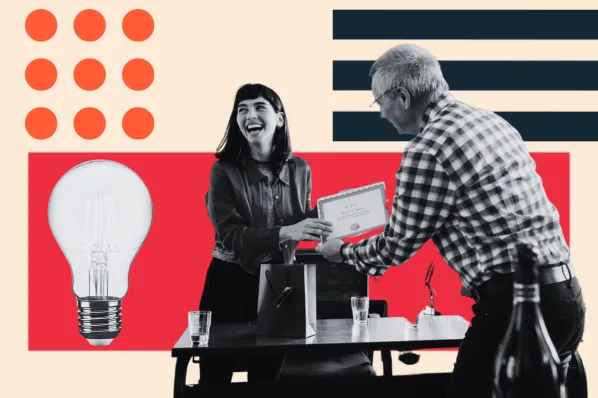Motivation is a key factor of sales success.
Besides simply being motivated to do their job, sales professionals also need to be motivated to push past rejections, deals that fall through, and pipelines that are hard to manage.
There are various tried and true methods that sales leaders can use to motivate their teams, like comprehensive training programs, building trust, and constructive feedback. Gamification is another strategy and, while it may seem like a fad, is a valuable tool to consider because it plays on basic psychological principles of motivation.
In this post, we’ll briefly explain sales gamification, outline the psychology that makes it work, and give expert tips from sales leaders that you can use to implement a strategy to motivate your teams.
Download Now: Free Sales Training Plan Template
What is sales gamification?
Sales gamification is the process of turning pipeline tasks, like calling prospects, setting meetings, and closing deals, into a game. Completing tasks often comes with a reward, which motivates salespeople to continuously repeat the behaviors that helped them succeed.
For sales leaders, gamification is primarily about understanding how to leverage innate human psychology to motivate and engage reps. When implemented correctly, gamification creates engaged and successful teams that are motivated, productive, and drive business revenue.
Modern gamification typically uses technology that creates a game-like simulation for reps to “play” on. Here’s an example of a gamification tool leaderboard from Heptaward.

Below we’ll discuss the psychology that makes gamification so effective.
The Psychology Behind Sales Gamification
Sales gamification is based on the psychological principle of operant conditioning. Popularized by B.F. Skinner, the model says that the consequences of a behavior determine the likelihood of it being repeated. Behaviors that receive positive reinforcement, like rewards or praise, are most often repeated.
A common example of operant conditioning is dog training. When teaching a dog a trick, dogs will get treats after performing the desired behavior, like sitting on command. Treats are positive reinforcement, so the dog is motivated to repeat the action to receive one. In time, sitting when told becomes a natural behavior that the dog has learned through positive reinforcement.
The same logic applies to sales gamification. When reps are rewarded for behaviors that contribute to sales success, they’re motivated to repeat them. Eventually, behaviors that receive positive reinforcement become normal, and the need for reward goes away. Dogs sit when asked, and salespeople become better at their jobs.
When implemented correctly, gamification works. Consider the following statistics:
- 89% of people say that gamification makes them more productive at work.
- 71% of employees believe that gamification leads to an increase in energy levels.
- Employees at Microsoft are 3.5 times more engaged since implementing gamification.
- Kenco implemented a sales gamification tool that gave them a 45% increase in bottom-line sales margin.
Given its benefits, it’s important to understand how to implement the practice.
Best Practices for Implementing Sales Gamification, According to Experts
We’ve asked expert sales leaders about their best-practices for implementing sales gamification, and we’ll discuss their insight below.
Understand what matters to your reps.
Mintis Hankerson, Senior Manager on the sales strategy team at HubSpot, says that a critical component of successful gamification is understanding what motivates your reps. Having this understanding helps her reward her teams in ways that help them feel encouraged to succeed.
To get this understanding, Hankerson says, “The easiest place to start is to send out a survey or questionnaire to ask reps questions like ‘How do you like to be held accountable?’ and ‘If you close a big deal, how do you want to be praised?’”
In practice, using this tip means that you opt to celebrate reps based on what feels most satisfying to them, whether it’s a team-wide email, a bonus, or a 1:1 congratulatory meeting.
Set clear goals and objectives.
Travis Haninger, Co-Founder and VP of Customer Experience at SequoiaCX, says that setting clear goals and objectives is crucial to a successful gamification program.
He says, “Yearly objectives should be deconstructed into weekly/monthly/quarterly tasks, and incentivized.” This makes larger initiatives feel achievable and gives reps the ability to understand the larger business vision and how their success contributes to it.
Haninger says that involving reps in the goal-setting process is also essential. When they have a say, productivity rises as they understand expectations and set the bar for success. He adds that involving reps also “Enables teams to self-organize, freeing leaders to focus on coaching and removing obstacles.”
Reward behaviors, not numbers.
Cody Normand, Senior Manager of Sales Productivity and Enablement at HubSpot, believes that gamification can be a powerful tool, but only if you set it up correctly and focus on the right inputs. To him, focusing on the right inputs means designing a gamification program around behaviors that help reps succeed in their objectives.
Normand poses a hypothetical of wanting to gamify deal creation. He’ll set up rewards for reps who create the most qualified deals rather than the most deals. He says, “The key word there is qualified. I would not want to gamify whoever creates the most deals because that’s not necessarily the behavior I’m looking for.” Instead, gamifying the behavior that leads to success stops reps from going out and creating unqualified deals, which would hurt productivity and overall business goals.
He adds, “I can’t stress enough the importance of being extremely focused on what you want to gamify and what will make the highest impact on your numbers. You must stay focused on the right behaviors and inputs that achieve the highest outputs.” This ensures that reps are learning something from the gamification process, not just working to receive rewards.
Unify teams.
Haninger believes that gamification can be a powerful tool for uniting teams and increasing productivity, especially when a team faces challenging quotas or emotionally draining tasks.
He says that one of his greatest career successes came from deploying gamification in a newly-formed team with multiple skill sets but no previous sales experience. The primary goal was to create a program to develop relationships and expand sales. He says, “Together, we were able to leverage our diverse skills and knowledge and motivate one another to achieve the uncomfortable and unknown.” He adds, “We exceeded all expectations.”
Instead of groups of subordinates working on tasks for pay, unifying teams help you foster a group of advocates whose rewards include mastery, autonomy, community, and peer recognition. Haninger says that, when done well, “Gamification promotes cultures that produce fulfilling work and incredible results.”
Build momentum.
Trygve Olsen, the Director of Business Development at BizzyWeb, believes that sales gamification is best used to build momentum, as sales is an independent sport, like distance running, that causes reps to spend time on individual, rote tasks with little excitement.
Olsen says that gamification allows reps to have fun with their team and, by extension, be competitive with their peers: “Creating games gives them quick wins to build momentum. Much like a flywheel, a salesperson who has wins under their belt will create more confidence and more wins with new prospects.”
At BizzyWeb, reps pass around a CD of Deep Blue Something’s Breakfast At Tiffany’s to the person that has sold the biggest retainer of the year. Olsen says that the CD serves as a trophy and a conversation starter, as reps have the opportunity to talk, learn from, and encourage each other to keep going. He adds, “It’s currently prominently displayed behind the person who has it, so every time he gets on a Zoom call, it’s cleverly within eye line.”
Celebrate successes and wins as a team.
Although gamification can offer rewards to individual reps, Haninger says that victories should be celebrated as a team. He suggests holding “Regularly scheduled and open meetings where team members present their achievements/progress, declare what they plan to accomplish next, and share challenges.”
This is a valuable tip, as competition can quickly turn into an every-rep-for-themselves type model, which negatively impacts performance as individual successes directly impact team-wide success. Haninger says, “When executed poorly, gamification can stir unhealthy competition and create teams that only focus on what has been incentivized, rather than larger company objectives.”
Use gamification tools.
Haninger’s final tip is to measure gamification metrics and results in accurate, automated systems.
Although the gamification aspect stems from receiving rewards, you can further gamify your process with interactive interfaces that help reps visualize their success and feel like they’re actually playing a game.
Gamifier
Gamifier is a feature-rich tool that will help you turn routine tasks into fun activities that promote healthy competition and productivity.
You can create challenges, quests, and journeys for your teams to participate in and reward them for completion. Reps can monitor their progress on a leaderboard and understand how teams work together to meet sales goals.

Spinify
Spinify, voted “Best Usability,” “Best Relationship,” and “Most Implementable,” is a high-quality platform that will help you motivate reps and drive engagement through virtual competitions. You can gamify targets and KPIs and send personalized video rewards to reps that meet their goals.

Compass
Compass is a cutting-edge sales gamification software designed to revolutionize the way sales teams operate, making the process not only more efficient but also enjoyable. With a focus on driving higher revenue growth, Compass introduces innovative features that transform sales activities into engaging and rewarding experiences.
Compass introduces a dynamic approach to boosting sales performance through gamified contests. Sales managers can effortlessly create competitions tailored to specific Key Performance Indicators (KPIs), such as milestones, races, counters, and bingo. This flexibility ensures that the challenges align with organizational goals, encouraging lasting positive behavior changes among team members. It creates a performance-driven culture that propels sales teams to new heights of success.
SalesScreen
A SalesScreen internal study found that teams using the platform saw, on average, a doubling in sales activity. You can use the tool to create interactive games and contests for completing targets and KPIs, and reps can monitor their progress in game-like screens.

If you want to lead a team of high-powered, successful sales reps, mind the recommendations of sales leaders and leverage innate human psychology to create a gamification strategy that rewards reps for their successes and motivates them to continue building on their skills.
In time, you’ll likely have a group of powerful salespeople that have no problem qualifying leads, closing deals, and driving business revenue.






